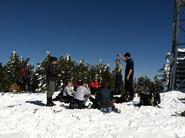
Students in Janelle Schwartz’s Reading the Extreme in World Adventure Narratives class are doing a lot more than reading this semester.
Schwartz, a 1997 Hamilton graduate and visiting assistant professor of comparative literature, has teamed up with The Hamilton Outing Club (HOC) to bring experiential learning to her students. The class has been reading about harrowing survival tales, races for the summit, spiritual journeys across ice and snow, and the impact of humanity upon remote and extreme landscapes. This semester, as the students descend in their readings from Everest on high to frigid arctic waters, they’re actually learning firsthand what it’s like to be part of an unforgiving wilderness, in a much more scaled down and safe way, through activities that HOC organizes for them.
“In the spirit of the interdisciplinarity embraced by Hamilton’s Comparative Literature department, ‘Reading the Extreme in World Adventure Narratives’ combines non-fiction adventure narratives and studies of world culture with outdoor leadership in order to explore the relationship between ‘arm-chair adventuring’ and being ‘out there’ confronting the natural milieu,” explained Schwartz. The class is recounting their adventures in a blog .
“It seeks to make less abstract such extreme feats of human endurance, so that the students can gain a more concrete understanding of the exploration and epiphany, tragedy and triumph, politics and ethics that accompany such activity,” she said.
With this in mind, the class meets at the Glen House, HOC headquarters, several times throughout the semester. They have an open climb each Friday at the climbing wall, plan to learn orienteering and wilderness first aid, and to take several hikes in the Adirondacks. “We’re fortunate to have the expertise of Andrew and Sarah Jillings at our disposal, as well as the facilities and equipment of the Hamilton Outing Club (HOC),” Schwartz noted.
One of the highlights of the semester was the “Everest obstacle course,” after reading Jon Krakauer’s Into Thin Air, about the 1996 disaster on Mount Everest, and Jamling Tenzing Norgay’s Touching My Father’s Soul, which weaves together the story of the author’s father and the author’s own summit success on Everest in 1996.
The course consisted of a line strung up on the porch of the Glen House to simulate a fixed line on Everest, replete with a “dead body” (or log, in the case of the class) tied to a part of the line, so that the students could experience how the climbers on Everest would have to unclip from their “life line” to negotiate around fallen climbers. Likewise, the students were dressed in full cold-weather gear, given ice axes, jumars (ascending devices), helmet, and crampons (metal spikes attached to the bottom of one's mountaineering boots).
Schwartz is enthusiastic about the balance of physical and mental exertion that the class brings, thinking that the students get a great deal more out of learning through experience than they would if they sat in their cozy chairs by the fireplace and simply read the stories. She wants the students to be able to engage their minds in their own adventures, not only to better understand the accounts they’re reading, but for their own personal benefit.
Schwartz hopes that the activities that the students do through HOC will allow them to create “a wonderful feedback loop between literature and outdoor leadership: they mutually inspire each other -- the adventurer brings back his or her story and the literature goes on to inspire new adventures,” she remarked.
The students have responded well to the “experiential learning” and are overall very excited about getting to do things through the Glen House, the Hamilton Outing Club’s headquarters. Anna Bastidas ’13 commented that she loves how “this class allows me to combine my academics with what I do in my free time.”
Schwartz said that whenever possible, she puts the literary readings the students discuss in the classroom into active, “real world” contexts. Thus, when they were reading texts about expedition and alpine climbing, the class learned how to properly pack a pack for a climb, discussed cold weather survival techniques, such as how to avoid hypothermia and how to splint a broken femur.
Schwartz explained, “With this, the students were broken into groups, each having a ‘victim’ who went outside and laid in the snow to simulate a femur fracture on the mountain.
“Each group then had to splint their ‘victim,’ as well as fend off the impending effects of hypothermia, and get him/her to safety (the back porch of the Glen House),” she said. “This exercise helped the students better imagine the necessity of both teamwork and individual strength (physical as well as mental) when climbing in the backcountry.”
“When our reading moves from the mountain to the sea, winter to summer, we will be heading back to the Adirondacks for a canoe trip in May,” Schwartz continued. She noted that all activities are “challenge by choice so students aren’t forced to participate.
She concluded, “It’s become clear to the students that literature informs climbing just as much as climbing forms the literature they are reading. ‘Adventure’ can then take on a greater scope, to include both readers and climbers alike, and to put equally into play the imagination and physical and mental endurance.”
Posted March 28, 2013
